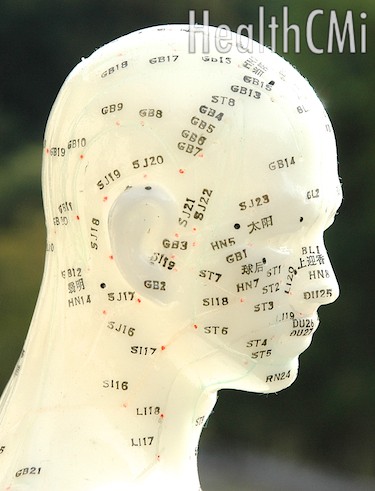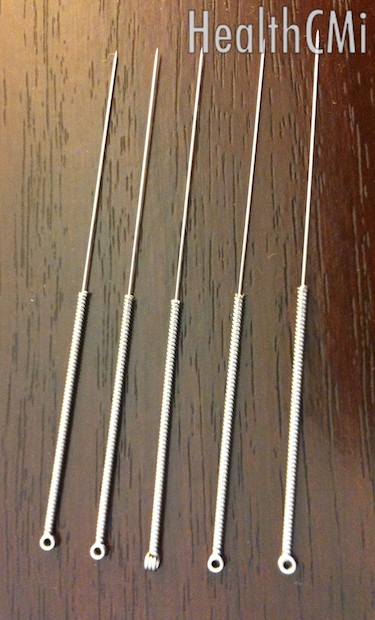Acupuncture effectively reduces pain according to research published in The Journal of the American Medical Association (JAMA).  Acupuncture groups had significantly greater reductions of pain than both non-treatment control groups and sham (imitation/placebo) control acupuncture groups in multiple high quality studies. Specifically, acupuncture was found effective for reducing pain associated with osteoarthritis, chronic headache, shoulder pain, nonspecific musculoskeletal pain, neck pain and back pain.
Acupuncture groups had significantly greater reductions of pain than both non-treatment control groups and sham (imitation/placebo) control acupuncture groups in multiple high quality studies. Specifically, acupuncture was found effective for reducing pain associated with osteoarthritis, chronic headache, shoulder pain, nonspecific musculoskeletal pain, neck pain and back pain.
The researchers from Memorial Sloan-Kettering Cancer Center, New York and Technical University, Munich underscored the importance of this latest research. They note that prior meta-analyses and systematic reviews of acupuncture for the treatment of pain included research of “variable quality.” In this new study, the scope was “restricted to high-quality trials.”
The researchers started with 31 eligible studies with a total of 19,827 patients. Studies were accepted only from the United States of America, United Kingdom, Germany, Spain and Sweden. Only studies with controls were included. Controls included no-acupuncture and sham/placebo acupuncture. All studies were conducted between 1996 and 2008. The researchers refined the studies down to 29 from the original 31 to preserve the highest quality evidence profile.
The clinical results demonstrated acupuncture to provide a “good response” to pain reduction in 50% of all cases. Sham/placebo acupuncture groups demonstrated the ability to reduce pain in 42.5% of cases and no-acupuncture controls demonstrated pain reduction in 30% of all cases. Some concern was expressed by the researchers that the sham/placebo acupuncture groups received active true acupuncture because some of the sham/placebo techniques “involved skin penetration.” They note that the sham/placebo acupuncture may not be “physiologically inactive.” As a result, some of the successes with sham/placebo acupuncture may reflect true acupuncture results. The researchers note “trials that include sham acupuncture as a comparison may underestimate the effects of acupuncture on pain reduction.” Another consideration is that these controlled studies involve blinding and standardization. As a result, the benefits of acupuncture may be underestimated because a true clinical setting involves customization of acupuncture procedures according to an individual patient’s differential diagnosis.
The researchers note that many established guidelines recommend acupuncture. They cite, for example, that the American College of Physicians’ guidelines recommend acupuncture for the treatment of back pain. Also, the UK National Institute for Health and Care Excellence (NICE) guidelines officially recommend acupuncture treatments for both chronic headaches and migraines when unresponsive to pharmaceutical medications.
This level of meticulous review establishes acupuncture as a standard and effective tool for the treatment of pain. This research has been published just after a recent discovery by investigators at Rutgers University Medical School, New Jersey that acupuncture reduces inflammation. The surgery department researchers proved that electroacupuncture fights infections including polymicrobial peritonitis and reduces severe systemic inflammation due to infections, sepsis. The researchers documented that the anti-inflammatory effects of electroacupuncture “are voltage dependent.” Non-acupuncture points (sham points) did not exert anti-inflammatory responses and “electroacupuncture with a wooden toothpick” did not reduce inflammation. Only true acupuncture was effective in regulating both dopamine and cytokine levels and produced anti-inflammatory effects that prevented death. 
The researchers note that the anti-inflammatory mechanism of electroacupuncture is “mediated by the sciatic and vagus nerves that modulates the production of catecholamines in the adrenal glands.” The researchers documented that electroacupuncture reduced lipopolysaccharide-induced serum levels of cytokines, reduced inflammation and prevented death due to sepsis.
There is a powerful take away from the latest research. Not only is acupuncture effective but it is irresponsible and uninformed to dismiss it. The data is in and acupuncture is a valuable treatment modality. There is a great need in modern clinical settings to provide enhanced relief from pain to alleviate suffering. Moreover, acupuncture’s anti-inflammatory actions demonstrate that it saves lives by preventing sepsis.
Healthcare Medicine Institute (HealthCMi)
HealthCMi publishes acupuncture continuing education courses online for acupuncture CEU, PDA, CE and CAE credit for the USA, Canada and more. The HealthCMi news division provides up-to-date news on Traditional Chinese Medicine (TCM), Traditional Korean Medicine (TKM). Traditional Japanese Medicine (TJM) and other branches of acupuncture, herbal medicine, qi gong, tui-na and dietetics.
References:
Vickers AJ, Linde K. Acupuncture for Chronic Pain. JAMA. 2014;311(9):955-956. doi:10.1001/jama.2013.285478.
Rafael Torres-Rosas, Ghassan Yehia, Geber Peña, Priya Mishra, Maria del Rocio Thompson-Bonilla, Mario Adán Moreno-Eutimio, Lourdes Andrea Arriaga-Pizano, Armando Isibasi, Luis Ulloa. Dopamine mediates vagal modulation of the immune system by electroacupuncture. Nature Medicine, 2014; DOI: 10.1038/nm.3479.


